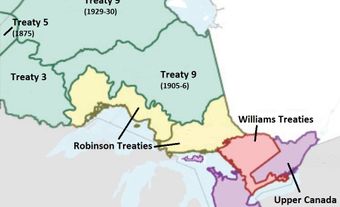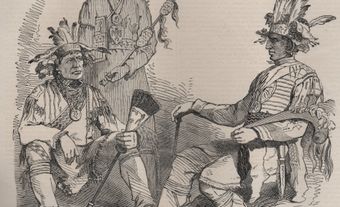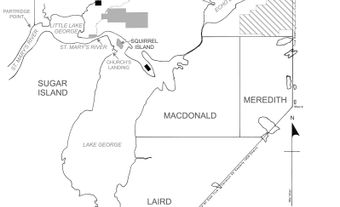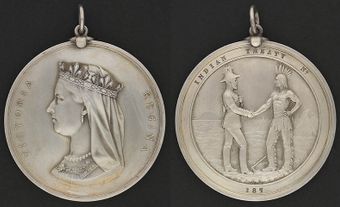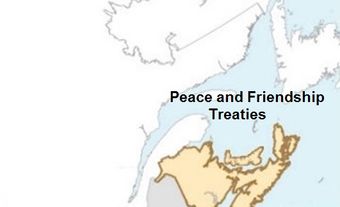In July and August 1764, Sir William Johnson and approximately 2,000 people, representing approximately 24 First Nations, met at Niagara to discuss an “alliance with the English.” (See also Niagara Peninsula.) The discussion led to the acceptance of the Royal Proclamation of 1763. It also included one of the first land cessions under the Royal Proclamation’s protocols, a return of prisoners, and an accepted British presence in the Great Lakes area. The resulting treaty was recorded in wampum. In the contemporary era, the 1764 Treaty of Niagara is not recognized by the Canadian government but is seen as a foundational document by First Nations for all subsequent relations and treaties. (See also British-Indigenous Relations Pre-Confederation.)

The Covenant Chain Wampum presented by Sir William Johnson at the conclusion of the Council of Niagara. This replica was commissioned by Nathan Tidridge and created by Ken Maracle of the Cayuga Nation.
(courtesy Tidridge/Wikimedia cc)
Context
With the conquest of New France in 1760, Britain needed to create a policy that would ensure peaceful settlement and relations with First Nations. In 1763, First Nations continued the conflict with the British by taking multiple forts throughout the interior as well as besieging Fort Detroit and Fort Pitt. At the same time, the British government outlined its “Indian” policies in the Royal Proclamation of 1763. Sir William Johnson, the superintendent of Indian affairs for the northern colonies, was instructed to establish peace with the interior or western First Nations. He began in late 1763, circulating copies of the Royal Proclamation accompanied by strings of wampum to the First Nations from Nova Scotia to Hudson Bay to the Gulf of Mexico and the Mississippi River using messengers from the Algonquin and Nipissing First Nations. Additionally, Johnson presented the Proclamation and explained its clauses to the Haudenosaunee Confederacy in December 1763. He called for a congress to be held at Niagara in the summer of 1764.
Treaty Talks
By July 1764, approximately 2,000 people from roughly 24 First Nations had gathered in Niagara to meet with Johnson. These included representatives from the Haudenosaunee, Detroit Wyandot (see also Huron-Wendat), Anishinaabeg, Menominee, as well as those from the Seven Nations of Canada and the Western Confederacy. The Detroit Odawa, Sandusky Wyandot, and Ohio Shawnee refused to attend the conference. Worried about British dishonesty, Pontiac, who was a key leader of the renewed warfare, also did not attend the discussions in 1764. However, he signed a preliminary peace treaty in 1765 and a final treaty the year after. (See also Treaties with Indigenous Peoples in Canada.)
Throughout July, Johnson and the British Indian Department fed and entertained the assembled people while discussing the Royal Proclamation, peace, prisoners, land, and the restoration of the relationship between the English and First Nations. Initially, Johnson sought separate agreements with the various nations present, but a united front prevented these efforts. The chiefs regularly conferred with each other in Johnson’s absence. Throughout the negotiations, Johnson offered the resumption of trade if an agreement was reached. If the nations failed to reach an agreement, however, he threatened that the British Army and the Haudenosaunee would destroy them. While the impact of the British Army threat is debatable, withholding trade was a more effective threat. Many First Nations had become reliant on western trade goods, and lack of trade was causing social hardship and disruption in communities. Regardless of the effectiveness of Johnson’s threats, by 1 August 1764 Johnson and the represented First Nations came to an agreement.
Promises and Outcomes
Part of the agreement reached by August was the surrender of a four-mile strip of land along the shore of the Niagara River by the Seneca. The strip secured the portage and road to the fort. It also allowed the Seneca to renew their peace and friendship with the British after they had attacked British troops along that path in September 1763. This surrender was one of the first land cessions made under the protocols of the Royal Proclamation. The cession by the Seneca, and the apparent acceptance of the land transfer by the assembled leaders, also indicates a broader Indigenous acceptance of the Proclamation itself. (See also Upper Canada Land Surrenders.)
The acceptance or understanding of the 1763 Royal Proclamation’s clauses relating to First Nations and their lands is the most important outcome at Niagara. Through his explanations of the Proclamation, Johnson assured those present that the interior was “Indian country,” that trade would be regulated and continue, and that they would be assured the Crown’s protection. Additionally, the First Nations agreed to the repatriation of prisoners taken in 1763 and to cease contact with Britain’s enemies, specifically the French on the western banks of the Mississippi River. Johnson, on behalf of Britain, promised to re-establish gifts, pay compensation for traders’ losses as a result of the 1763 conflict, allow free passage for First Nations and traders across the Proclamation line, and prosecute settlers who committed crimes against First Nations. The treaty established or extended the Covenant Chain, originally between the Haudenosaunee and the British, to those First Nations living in “Indian country.”
Niagara Treaty and Wampum
The Niagara agreement was entered into the wampum. Approximately 84 wampum belts were exchanged during the treaty council representing negotiations between various First Nations. At the conclusion of the council, Johnson presented a Covenant Chain wampum belt to the Western Confederacy. The two figures holding hands on the belt symbolized friendship and alliance that bind Indigenous nations and the Crown, while the hexagons represented council fires. Johnson presented the Twenty-Four Nations Wampum to the nations. It symbolically showed they were all in a relationship. A Two-Row Wampum belt was given to Johnson by the First Nations. It indicated Indigenous understandings of the treaty and the Proclamation. Johnson also presented 24 medals to the nations present, dated 1764, with an image of an Indigenous person and a settler peacefully smoking under a tree. Together, the wampum belts and medals, as well as the accompanying presents, established a peace and alliance between all the parties at the council and the British Crown.
Legacy and Significance
The First Nations who agreed to the Niagara Treaty fought as allies with the British in the American Revolution and the War of 1812. Indigenous involvement in both of these conflicts, particularly the latter, ensured British North America’s survival. (See also First Nations and Métis Peoples in the War of 1812.) Sir Francis Bond Head, while negotiating a treaty in 1836, was reminded by Chief Assickinack of Manitoulin Island of the terms of the Treaty of Niagara.
While Canada does not officially recognize the 1764 Treaty of Niagara, First Nations see it as foundational to their understanding of the Royal Proclamation as well as establishing a nation-to-nation relationship with the British Crown. According to John Borrows, an Anishinaabe legal scholar and theorist, the Royal Proclamation cannot be understood without the presence of the Niagara Treaty. Simply, the Proclamation by itself only represents the Crown’s understanding of the relationship; together, the Proclamation and the Treaty of Niagara represent a more rounded understanding of the Indigenous-Crown relationship. In fact, Borrows notes that, taken together, the two documents mandate non-interference of the Crown in Indigenous governance and lands as well as recognizing Indigenous sovereignty. The Crown, however, disagrees.

 Share on Facebook
Share on Facebook Share on X
Share on X Share by Email
Share by Email Share on Google Classroom
Share on Google Classroom


